11 Best first-time Europe itineraries for 1, 2, or 3 weeks
Europe is going to be very busy in the summer of 2024 as the world is back to normal and travel demand is higher than ever. One other key factor is that most European currencies are still hovering at lower levels historically compared to the US dollar, which means that Europe will feel somewhat cheap again this year. In fact, according to our World Backpacker Index, European cities like Lisbon, Madrid, and Munich are about 30% cheaper to visit than Boston, Chicago, and New York City. In other words, flying to Europe might seem expensive, but most things will be cheaper once you get there compared to the costs of visiting a large US city.
Below you’ll find 11 of the most popular and best itineraries for a first visit to Europe. Your first visit is not really the time to be different or creative, and the famous destinations tend to be popular for a reason. In other words, it’s kind of silly to visit, say, Bulgaria, if you’ve not yet been to France or Italy. I lay out the best options along with how long to stay in each place as a general guide. I also discuss Mediterranean cruises, which can actually be an amazing way to see a lot of Europe on your first visit, especially if you don’t like going back and forth to train stations and airports every 2 or 3 days.
For a bit of fun you might be interested in the cheapest 5-star hotels in Europe, which start at US$80 per night for really nice hotels. It helps show that if you choose some of the cheaper cities, you can treat yourself to some luxury that you can’t afford in most other places.
This article was last updated in March, 2024.
There are 11 starter itineraries described in detail below
- Classic London and Paris
- England and Scotland
- Paris and Italy
- Mediterranean cruise
- France, Belgium, and Netherlands
- Paris and elsewhere in France
- Italy
- Spain
- Germany
- Switzerland
- Best of cheap eastern Europe
For each itinerary there are suggestions of other destinations that are easy to add on to the main cities.
Note: This article was most recently updated in March, 2024
Building the best itinerary for your first trip to Europe
Below there are 11 popular itineraries for one week in Europe. If you’ve only got a week then choose one of them and assume you’ll return again to conquer more of this amazing part of the world. If you’ve got more time then you can choose from some of the top add-on suggestions for each one.
Start in the most famous cities
Your first visit to Europe is no time to try to be different or edgy. I recommend that you focus on these 5 great cities before you start branching out into cheaper or more obscure places.
Keep your travel days to a minimum
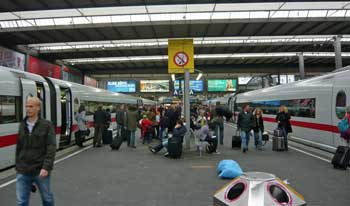
Spend 3 (or 4) nights in almost every major city
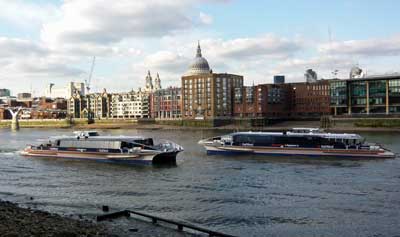
So many first-time visitors are initially planning on spending only 1 or 2 nights in major cities that I wrote a detailed explanation of why 3 nights is ideal for almost all European cities, even if you want to see as much as possible.
3 (or 4) nights will be enough for any city on your first trip
Most first-time visitors are tempted to move too quickly, but it can also be a mistake to move too slowly. It’s really amazing how much you can see in two full sightseeing days. If you spend too long in one city you’ll end up seeing things that are way down your list, while you could be in another city seeing things at the top of your list there.
Choose cities that are easy to reach from each other
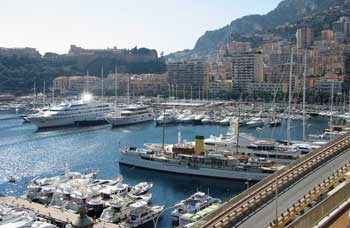
For your first trip it’s best to visit cities that are no more than a 5-hour train ride apart.
Choose cities that are connected by reasonable train rides rather than flights
To build on the point above, finding cheap flights within Europe is easy, but train travel is about a million times more enjoyable and less stressful. You’ll enjoy the train rides almost as much as the cities, so focus on places that are within 5 hours of each other by train.
Start with one of the classic itineraries below, and then add to it if you have more time
If you only have 7 days then you’ll find a list below of classic itineraries that are well-suited to a first visit to Europe. Hopefully you have more than 7 days though, and if you do you can add in one or more of the suggested add-on cities to build an itinerary that appeals most to you.
Best 1-week itineraries for the first time in Europe
Itinerary 1: Classic London and Paris
Fly into either city and take the 2-hour Eurostar train between them
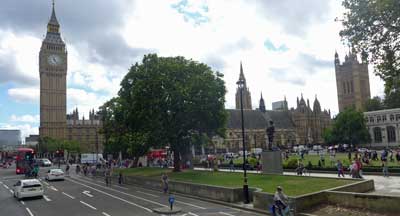
London highlights
- Big Ben and Parliament
- Westminster Abbey and St. Paul’s Cathedral
- Tower of London and Tower Bridge
- West End shows (Broadway equivalent) and classic pubs
- Buckingham Palace and Windsor Castle
Paris is actually far more beautiful than London and the food is famously much better as well. Since Paris gets so many tourists from non-French speaking countries, it’s easy to get by on just English, and the Metro system makes it fast and easy to get around. The architecture of both cities is amazing from the Tower of London, Big Ben, Westminster Abbey to the Louvre and the Eiffel Tower. These cities each pack a huge punch and they are very different from each other as well. Actually, England is arguably the best choice for your first trip to Europe.
Paris highlights
- Eiffel Tower
- Louvre Museum and Museum de Orsay
- Arc de Triomphe and other monuments
- Montmartre neighborhood and Sacré Coeur Cathedral
- Probably the world’s best affordable restaurants and wine
Best add-ons to London and Paris
- Edinburgh (2 or 3 nights, from London)
- Amsterdam (2 or 3 nights, from Paris)
- Bruges and Brussels (2 nights, from Paris)
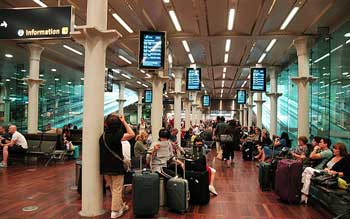
>>>Best one-week London and Paris itinerary in detail
>>>Check London hotel deals
>>>Check Paris hotel deals
Itinerary 2: England and Scotland
- London (3 or 4 nights)
- York (1 night)
- Edinburgh, Scotland (2 or 3 nights)
- Inverness, Scotland (2 or 3 nights)
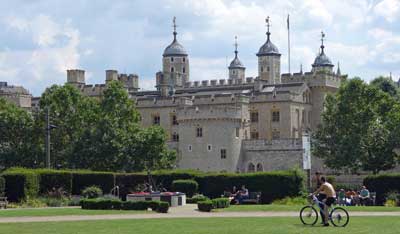
York is a small Roman city with intact city walls and one of the most famous cathedrals in Europe. Edinburgh is not only the capital of Scotland, but it’s easily the second most interesting city in all of Britain. If your time is short, skip York and spend more time in Edinburgh.
If you prefer to focus on the south of England on your first trip then the best option is to go to Bath or nearby Bristol after London. Bath is another of England’s top destinations and it’s a gorgeous city that has been a spa resort for many centuries. It’s also reasonably close to Stonehenge. You can also easily get to Cornwall in England’s southwest corner from Bath, and that’s a whole different and fascinating experience (with nicer weather than up north).
If you’ve got more than a week and want to spend more time in Scotland, especially in the summer months, the place to head to is Inverness. It’s a small town that is considered the gateway to the Scottish Highlands, but it’s an interesting and charming place on its own. You can take day-trips by bus to the highlights of the Highlands including the Isle of Skye and Loch Ness. Between you and me, it’s better to minimize time in Loch Ness or skip it altogether because it’s not one of the more photogenic parts of Scotland and the monster has always been a hoax.
Travel times between the recommended places
- London to York by train: 2 hours
- York to Edinburgh by train: 2.5 hours
- London to Edinburgh by train: 4 hours
- Edinburgh to Inverness by train: 3.5 hours
- London to Bath by train: 85 minutes
Best add-ons to England and Scotland
If you think you want to spend your whole trip in Britain you should have a look at our article on the best itineraries in England, Scotland, and Wales.
>>>Check London hotel deals
>>>Check Edinburgh hotel deals
Itinerary 3: Paris and Italy
- Paris (3 or 4 nights)
- Venice (1 night)
- Florence (2 or 3 nights)
- Rome (3 nights)
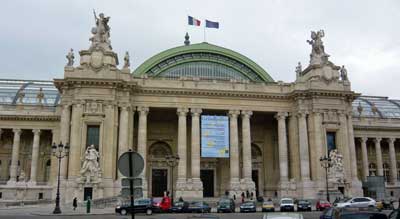
From Paris you can easily fly to Venice (or nearby Treviso) where you should try to spend about 24 hours. Venice is small enough to see in a full day, and so crowded that most people are satisfied to leave after that day. The key is to stay in the main part of the main island so you can enjoy Venice before the cruise passengers and day-trippers arrive, and also after they leave for the day. Two nights in Venice would not be wasted time, and it’s possibly the most gorgeous city in the entire world, but you can see the best of it in a bit over 24 hours.
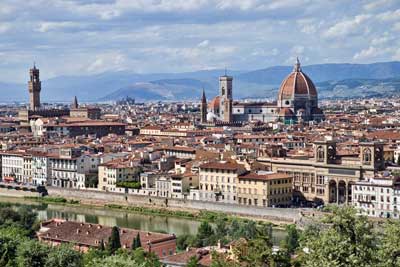
Rome also lives up to the hype and spending a day in the Vatican City will be a highlight even for non-Catholics, but it’s also a crowded and busy city so three days is usually enough for most people. Similar to Paris, Rome is an unusually beautiful city from almost any angle when you are in the historical center. You’ll walk through a stunning piazza (town square) and then turn a corner and you’ll see gorgeous buildings or public statues that are as nice as anything in the museums. Seriously, it’s worth a visit.
Paris to Venice flight: 1 hour 35 minutes
Venice to Florence by train: 1 hour 53 minutes
Florence to Rome by train: 1 hour 16 minutes
You can of course instead fly from Paris to Rome and then go north to Florence and then to Venice and fly home (or back to Paris) from there, and it would be just as enjoyable.
Best add-ons to Paris and Italy
France
- Nice/Cannes/Monaco (2 or 3 nights)
- Avignon (2 nights)
- Bourges (2 nights)
- Bordeaux (2 nights)
- Aix-en-Provence (2 nights)
- Reims (2 nights)
- Dijon/Burgundy (2 nights)
Italy
- Milan (1 or 2 nights)
- Lake Como (2 nights)
- Siena (2 nights)
- Cinque Terre (1 night)
- Naples/Sorrento/Amalfi Coast/Pompeii/Capri (3 to 5 nights)
- Sicily (3 to 4 nights)
>>>Much more information in this article about the best France and Italy itineraries
>>>Check Paris hotel deals
>>>Check Venice hotel deals
>>>Check Florence hotel deals
>>>Check Rome hotel deals
Itinerary 4: Mediterranean cruise
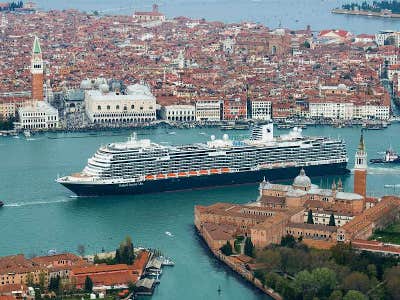
In spite of the reputation of cruises to be floating buffets, they can actually be an excellent way to visit a great number of amazing European cities in a short time. The ship typically is in port from the early morning until mid evening, often giving you the opportunity to have dinner in the city (unlike Caribbean cruises). Better still, the cruise ports are often near the center of town, so you can just walk off the ship and do sightseeing on foot or by public transportation.
Mediterranean cruises usually start at 7 nights but can go up to 3 weeks, which can provide an amazing tour of the entire region without having to pack and repack your bags more than once. They also can provide excellent value, especially compared to the price of taking trains or flights and finding new hotels in every destination.
Most popular Mediterranean departure ports
Barcelona, Spain – It’s an easy port to reach. Ships generally go from Barcelona with stops in France and then Italy.
Rome (Civitavecchia), Italy – The port isn’t very close to Rome, but it’s easy to get back and forth. Ships go west to France and Spain as well as south around the tip of Italy and then on to Croatia, Venice, and to Greece.
Venice, Italy – The cruise ships no longer dock close to the best tourist areas, but it’s easy enough to visit Venice for a day or two before boarding a ship. Ships starting in Venice go south and then head west and to Rome and then to France, or they go south to Croatia and then head east to Greece.
Athens, Greece – The cruise port of Piraeus is just south of Athens and easy to reach. Ships from Athens usually head west towards Croatia, Italy, France, and Spain, but there are also ships that visit Greek islands and Turkey.
>>>Check for deals on Mediterranean cruises
Alternative to consider: a river cruise
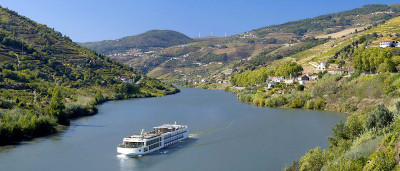
Amsterdam, Budapest, and Prague are some of the most popular river cruise ports, but there are dozens of others including many smaller towns in France where few other tourists will be when you stroll off the ship. There is little or no entertainment on the river cruise ships, but passengers don’t miss it because the entire day and into the evening is spent just steps from local cultural offerings and restaurants.
>>>Check for Europe and river cruise deals
Itinerary 5: France, Belgium, and Netherlands
Paris to Brussels: 1 hour 22 minutes
Brussels to Bruge: 58 minutes
Bruges to Amsterdam: 2 hours 45 minutes
Amsterdam to Paris: 3 hours 17 minutes
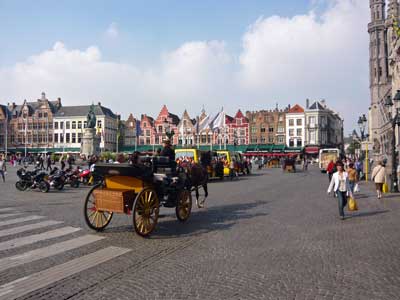
Spending 4 nights in Paris and 3 nights in Amsterdam would be a great trip, but if you want to see something else you’ve got a couple options in between. My advice is to spend an afternoon looking around the Grand Place (main square) in Brussels and then hop a 58-minute train ride to Bruges for a night or two. Brussels isn’t a great tourist city, but Bruges really is so it’s a better option for most people. Whatever you choose out of this group, you can be back in Paris on another high-speed train for your flight home.
Best add-ons to France, Belgium, and Netherlands
- Luxembourg City (1 or 2 nights)
- Cologne, Germany (1 or 2 nights)
- London (3 or 4 nights)
- Interlaken, Switzerland (2 or 3 nights)
>>>Check Paris hotel deals
>>>Check Bruges hotel deals
>>>Check Amsterdam hotel deals
Itinerary 6: Paris and elsewhere in France
- Paris (3 or 4 nights)
And a choice of:
- Nice/Cannes/Monaco (2 or 3 nights)
- Avignon (2 nights)
- Bourges (2 nights)
- Bordeaux (2 nights)
- Aix-en-Provence (2 nights)
- Reims (2 nights)
- Dijon/Burgundy (2 nights)
- Normandy (2 nights)
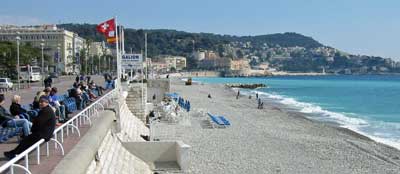
While Nice is a wonderful tourist city for a look at the French Riviera, the other larger cities of Lyon and Marseilles are probably better saved for a future trip because they are light on key sights compared to many smaller towns. Wine lovers can rent a car or take trains into Bordeaux or Burgundy. Since you can get between most of these towns by train in 2 hours or less, spending only 2 nights in each one is a reasonable option if you want to see a lot in a short time.
Normandy is an interesting choice and easy to reach in only about two hours by train from Paris. Some visitors like to see the famous WWII beaches and memorials, while others (especially in summer) like to check out one or more of the beach-resort towns. Deauville is one of the more famous of those, and it’s also famous for its horse race track and as one of the epicenters of the industry in Europe.
Best add-ons to Paris and elsewhere
- More France, of course
- London (3 or 4 nights)
- Interlaken, Switzerland (2 or 3 nights)
- Amsterdam (2 or 3 nights)
>>>Check Paris hotel deals
>>>Check Nice hotel deals
Itinerary 7: Italy
Rome to Florence: 1 hour 16 minutes
Florence to Venice: 1 hour 53 minutes
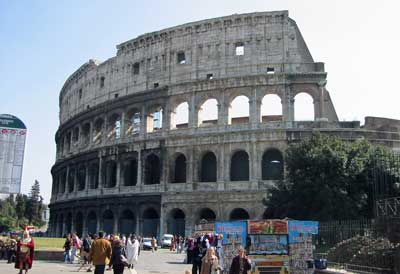
Venice is small enough that you can see the main sights in about 24 hours, and it’s so insanely crowded that many people tire of it after about a day as well. It’s better to pay more for a hotel to be on the main island and visit quickly than to save money with a hotel on the mainland where you’ll be in crowds going back and forth as well. Florence is the most relaxing of the 3, and also a great base for side trips to Pisa, Siena, and Cinque Terre, just to name a few.
Going to Italy? Here are the best first-time Italy itineraries for 3 days to 2 weeks (in much greater detail)
Best add-ons to Italy
- Milan (1 or 2 nights)
- Lake Como (2 nights)
- Siena (2 nights)
- Cinque Terre (1 night)
- Naples/Sorrento/Amalfi Coast/Pompeii/Capri (3 to 5 nights)
- Sicily (3 to 4 nights)
>>>Check Rome hotel deals
>>>Check Florence hotel deals
>>>Check Venice hotel deals
Itinerary 8: Spain
Madrid to Barcelona: 2 hours 30 minutes
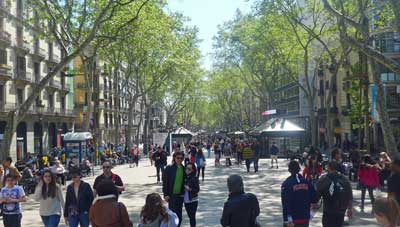
A huge part of Spain’s tourism industry is built around its southern beaches and islands such as Ibiza, Mallorca, and Tenerife (in the Canary Islands). For most people it’s best to ignore those places on your first trip because none of the beaches are special enough to spend days on them compared to the culture of the cities.
Best add-ons to Spain
By popular demand, I’ve added a full article on where to go in Spain with itineraries from 7 to 10 days up to two weeks.
>>>Check Madrid hotel deals
>>>Check Barcelona hotel deals
>>>Check Lisbon hotel deals
Itinerary 9: Germany
Berlin to Munich: 6 hours 2 minutes
Munich to Rothenburg ob der Tauber: 2 hours 56 minutes
Munich to Füssen: 2 hours 4 minutes
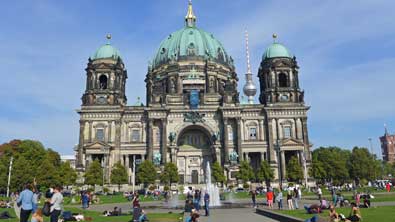
Those two cities are the keys to a Germany visit, and after that you’ve got a wide variety of choices. I cover most of the popular choices in my article on where to go in Germany, which covers several smaller towns that are major highlights.
Best add-ons to Germany
- Cologne (1 or 2 nights)
- Hamburg (2 or 3 nights)
- Amsterdam (3 nights)
- Prague (3 nights)
- Salzburg (2 or 3 nights)
- Vienna (3 nights)
- Interlaken, Switzerland (3 nights)
- Lucerne, Switzerland (2 or 3 nights)
>>>Check Berlin hotel deals
>>>Check Munich hotel deals
Itinerary 10: Switzerland
- Interlaken (3 nights)
- Bern (1 night)
- Lucerne (3 nights)
Zurich Airport to Interlaken: 2 hours 10 minutes
Interlaken to Bern: 53 minutes
Bern to Lucerne: 1 hour 50 minutes
Lucerne to Zurich Airport: 1 hour 3 minutes
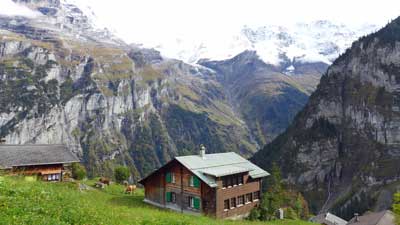
Interlaken is the best hub for the most dramatic Alps views and experiences. The one-hour cable car ride up to the Schilthorn observation deck is something you’ll never forget, and the only thing that might be more dramatic is the train ride up to the Jungfraujoch station, which is the highest in Europe. Lucerne is almost as beautiful with a scenic lake at its heart and also great mountaintop views nearby. If you do want to see a Swiss city then the capital of Bern is the most interesting and photogenic on a short visit. Read more about where to go in Switzerland for even more ideas.
Best add-ons to Switzerland
>>>Check Interlaken hotel deals
>>>Check Lucerne hotel deals
Itinerary 11: Eastern Europe’s best cheap cities
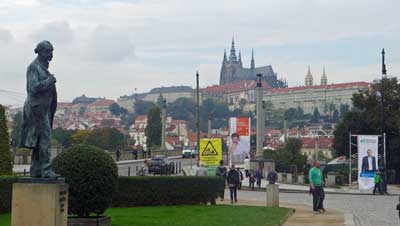
Each of these cities is beautiful and historic, but English is less widely spoken so they can also be quite a bit more challenging for a first-time visitor. Another difficulty is that the trains between them are still quite slow compared to the high-speed rail in the West, so it takes most of a day from one to another, and a bus is often a better choice. I cover this best cheap Europe itinerary more fully in the linked article.
Prague to Budapest: 6 hours 41 minutes
Budapest to Krakow: 9 hours 54 minutes (flying might be better)
Best add-ons to cheap Eastern Europe
- Cesky Krumlov, Czechia (2 nights)
- Ljubljana, Slovenia (2 or 3 nights)
- Split, Croatia (3 nights)
- Belgrade, Serbia (2 or 3 nights)
- Sarajevo, Bosnia and Herzegovina (2 or 3 nights)
- Sofia, Bulgaria (2 or 3 nights)
>>>Check Prague hotel deals
>>>Check Budapest hotel deals
>>>Check Krakow hotel deals


Hi! Thank you for this blog. So helpful. Question, I love Christmas season, decorations Christmas markets and festivities. Is it a great time to travel UK around first week of december? It will be me, my husband and our 11month old baby. What cities would you recommend? I am thinking London, Prague, France and Barcelona. Ior do you have a better suggestion? Thank you so much!
Johanna,
All of the larger cities in Europe will have nice Christmas displays and window shopping that time of year, although most of the events will take place later in the month.
It really depends on how long you have for the trip. I highly recommend 3 nights in each city even if you are trying to move quickly. As for France, you could obviously visit Paris, and you might consider Lyon as well, but the coastal towns will be rather quiet and in their off season.
You can go from London to Paris on the Eurostar train and then to Barcelona on a high-speed train, but Prague is way out of the way and you’d have to fly in and out. I might save that for another trip because it can also get chilly that time of year. Let me know if you have any other questions. -Roger
Thanks Roger for the advice.
I am considering Geneva to go to Glacier 3000 and a tour to Chaplin world, Montruex/Vevey.
We are also thinking of taking the Bernina Express tour…looks very interesting…
One day Zurich trip to Rhine Falls and Black forest…
In Interlaken, Jungfraujoch, and Grindelwald First.
Confused on which mountain excursions to go to out of Mt Titlis, Pilatus, Rigis, Schilthorn, Glacier 3000, Mount Blanc, Matterhorn (Zermatt), can you please suggest?
Thank you so much for your reply. I agree with you and we are going Italy during Christmas season. After which to Switzerland then Amsterdam then last stop will be Paris.
Can i check what kind of transport will you recommend for our trip?
Rachel,
I’d definitely go by train on as many of your stops as possible. The trains in Europe are comfortable, usually fast, and the tickets are generally quite cheap if you buy them at least a month or two in advance. Possibly more importantly, the train stations in most European cities are in the heart of the city and usually surrounded by hotels and restaurants. It’s often possible to check out of a hotel at 8:30AM and walk 10 minutes to the train station to board a departing train at 9AM with plenty of time to spare. Flying around Europe is as stressful as it is most other places and you have to leave the city at least 3 hours early to try to make it to the airport 2 hours before your flight and all of that. -Roger
Hi, we have our Europe trip coming this September which is for 9 days and flying in and out from Paris. Can you please help us plan the best itinerary as we have very few days and my family wants to cover, Paris>Brussels>Amsterdam>Germany. Is it possible? We are actually renting a car to go from place to place. Please suggest.
Hello Roger, I/we are frm Mumbai- india. We grp of frnd & fmly mostly senior like to visit Europe & U. K in May/June 2020. Our tours days 18/19 days. So plz. Suggest us best tour plan were we can see maximum country/city/place comfortably.we can add 1/2 days if needed.,but like to cover famous place by wonderfulway.your guideness will help to chalk out our plan par properly ,So plz we need your supports in this.
Shashikant,
If you’ve got 18 to 20 days I’d try to make a list of 6 or 7 cities you’d like to visit. The article above should give you plenty of ideas of the more popular groups of cities that people enjoy. It’s easy to start with London and Paris for 3 days each, so you’ve got 4 or 5 cities left. Many people like to visit Venice, Florence, and Rome as Italy’s “Big 3” destinations. You could go from London to Paris to Switzerland to Italy and that would be an amazing trip.
I generally don’t like to type out itineraries from scratch because everyone has different tastes and different budgets. See which places sound most interesting to you and put them at the top of your list. Then look for other cities that are easy to reach from your main picks, or are between them on train routes. I’m happy to help with more questions if you have them. -Roger
Hello Roger
You are great, you help a lot of people here.
I am Vijay from Mauritius and I wish to visit Europe with 3 friends in August 2020 for 3 weeks.
We planned to visit;
London-3N
Paris-1N
Venice-1N
Florence-2N
Rome-2N
Amsterdam-2N
Interlaken-2N
Barcelona-2N
with
Berlin, Prague as options
Need advice on our planning as it would be a low budget trip and your recommendations are welcome for the choice of routes and connections (flight / train / bus)
Thanks and greetings
Vijay,
I enjoy trying to help. First off, please have at least a scan of my article on why 3 nights is the best length of time to stay in nearly any European city. If you stay only 1 or 2 nights you’ll literally be spending half of your time in Europe on trains and in train stations, and it’s also much more expensive to do it that way. So if you are on a budget and you’ve got 15 nights to spend I’d choose 5 cities to visit.
If you choose cities that are close to each other or connected by fast trains, it’ll be much more pleasant and cheaper as well. If you’ve never been to Paris then I’d definitely stay 3 nights. If you’ve been there before you should probably skip it this time. It’s hard to see any sights on the day you arrive or the day you depart.
As long as you buy your train tickets at least a month or two in advance, the train fares are quite cheap. The trains are also MUCH more comfortable than buses and MUCH more enjoyable than flights. I hope this helps. I’m happy to help you more as your plan is coming together. -Roger
Hi Roger,
Planning a Swiss trip in Oct 1st week for 7/8 days. Need to decide our itenary and base.
Thinking of taking direct flight from India to Zurich and then take a train to Interlaken. May be staying at Griderwald and 2 days to see First and Jungfrau region.
Then train to Lucern and visit Mt Titlis/Mt Rigi and staying there for 2 days.
Not sure which other cities would be better to visit out of Bern, Geneva, Zurich.
Kindly suggest if the itenary looks good and anything else. We have a budget of 5/6 Lacs including flights.
Mrini,
Your itinerary looks really good. I think you might be helped by a scan of my main article on where to go in Switzerland.
If you’ve got 7 or 8 days I’d definitely spend 3 days in the Interlaken area and specifically in the Lauterbrunnen Valley, which has Jungfrau on one side and Schilthorn on the other. It’s arguably the most photogenic place on earth and there is plenty to keep you busy. I think 2 nights in Lucerne is enough, but 3 nights might be even better. Those tiny villages in the Lauterbrunnen Valley are nice, but the city of Lucerne also has a lot to offer including fantastic shopping and different local sights. The town of Interlaken itself is pretty nice, but Lucerne is quite a bit more interesting and charming.
As I mention in the article, I think Bern is the most interesting of the Swiss cities for a one-day or one-night visit. Geneva has a gorgeous location, but there isn’t much to see because it’s a business town. Zurich is all about banking and business as well, and it’s also very expensive.
A budget of 5 or 6 Lacs should be plenty for a great trip for two people if you can get the flights cheap enough and if you are talking about two people. You’ll probably want to get an 8-day Swiss Travel Pass for each person. It seems expensive at first, but the train rides and attractions in Switzerland are very expensive and if you are staying that long you’ll easily save money with it. At the very least you’d want to get a Half Fare Card for each person. Let me know if you have any other questions. -Roger
Rogery, thank you for such a prompt response. That’s so helpful. The grandson intentionally left Paris off his list since he has been there a number of times with his dad who lived in Paris a year.
A neighbor suggested looking into European or Iberian river cruises.Do you have any experience or suggestions regarding those?
I agree with your assessment of Ireland and will plan at this point to fly into London. The Churchill War Rooms are a big attraction there, so it will be something he will enjoy, more than Dublin. There’s still lots of planning to do regarding carts and mobility device availability, but great memories in the making. Thank you for all the time and effort you put into this. It’s like the “Ann Landers of Travel” .
Alice,
That makes sense about Paris. I thought there must be a reason it wasn’t on the list. And the Churchill War Rooms are very cool and especially for WWII buffs, so that should be a highlight.
As for European river cruises, I’ve yet to take one myself but I’ve heard a lot about them and nearly everyone who goes on one (including my mother) is a big fan. The ships are much smaller than ocean cruise liners, as you probably know. I’ve actually slept on one in Bratislava that is now just a docked hotel. I think one of those could be a great option for those two if you find the right combination of ports that interest them. Amsterdam is a pretty common port for the end of those cruises. Most of all it would be good for the mobility issue. The boats almost all dock in the heart of the city and usually there would be small buses and vans right there to take passengers on city tours. That is probably the most amount of sightseeing with the least amount of walking possible. Let me know if you have any other questions. -Roger
Roger,
This is one of the best places to research trip planning! We are seeking your help. Grand=dad, mobility challenged (can walk about 100 steps before sitting down)-and 18-y/o grandson on 3-week Europe trip in October. It’s a gift to the grandson, so wanting to “experience” as much of what he has listed, but focus on making memories. This is the grandson’s first ‘wish list’: Dublin, London, Amsterdam, Brussels, Dunkirk, Omaha Beach, American Cemetery, Nice/Monaco, Barcelona, Madrid, Granada, Lisbon, Malaga. HELP!
Alice,
It’s always a thrill to hear that people find this helpful because I really enjoy trying to help. If they’ve got 3 weeks to work with I’d recommend trying to focus on 6 to 8 total cities at the most. The mobility issue will obviously slow them down and it might mean that any more than 6 destinations could be a challenge. It’s strange the Paris didn’t make the list even though Nice and Normandy did. Especially in light of the mobility issue, I’d recommend looking into a tour (might be 2 days) that would start in Paris and visit Dunkirk and Omaha Beach and an American cemetery. I’m sure you can find a bus tour where walking would be minimal, at least compared to any other way of going. And I’d highly recommend 3 nights in Paris as well. It’s FAR more interesting than Brussels, for example.
Generally I think they’ll be best off focusing on train travel. Taking bus/coach tours would require less walking, but generally they move much slower than trains on the same route. Grandad would probably have to get a wheelchair or an electric cart shortly after entering the train stations, but that would be true of airports as well and the distances in train stations are usually MUCH shorter. On the other hand, most trains require reserved seats and many intercity trains have 10 or 12 carriages. This means even once you are at the front or back of the train it might still require a brisk 5-minute walk to reach your reserved seat. I’m pretty sure they have carts for those who can’t walk far because I’ve nearly been run over by dozens of them.
With that in mind, they could fly into London and then after 3 days there take the Eurostar train to Paris and after 3 days there they could do the Normandy D-Day tour. Amsterdam is only a bit over 3 hours by high speed train from Paris. Nice and Monaco should be nice in October, but they look even better in summer so I’d probably save those for another trip. If they went to Amsterdam they could fly to Barcelona and then spend the rest of the trip in Spain and Portugal. I’d probably save Malaga for another trip as well because it’s a bit out of the way on the Spanish train lines.
I’d probably save Dublin for a future trip as well. It would be easy enough to book a flight into Dublin and then after 3 days there fly on to London to start the rest of the trip. But personally I think Dublin itself is a bit overrated and I prefer Ireland’s smaller towns and scenery. In other words, I recommend a visit to Ireland is a day or two in Dublin and then a train or car rental to the castles and coastlines and smaller towns, and it would be hard for them to do that on this trip.
Again, I highly recommend spending 3 nights in almost any European city you visit because going any faster than that means spending every other day on trains or in airports, which really gets old pretty quickly. And with mobility issues, those journeys between cities will be slower and more challenging. I hope this helps and let me know if you have any other questions. -Roger
Roger
Thanks for keeping the article updated and answering questions patiently.
I will be traveling from India and would like to Europe from History/Heritage point of view, of course time permits other attractions as well.
I have 22 days planned from Sep 22nd to Oct 13th. Plan is to visit Paris, London, Cologne, Berlin, Vienna, Munich, Switzerland, Venice, Florence and Italy.
1. Will be on Vacation for the first two weeks (Hostel accomodation – Kinda backpacker)
2. Will be working from there last week (Oct 7 to 11). (Private accommodation with less time to see places only morning and evening)
3. Will be applying France Visa and planning to get UK Visa for London as well.
Please advise
Thiru,
I’m happy to try to help. First off, even for a backpacker staying in hostels, I highly recommend staying 3 nights in each place you visit in Europe. You’ve got about 10 places on your list (assuming you meant Rome rather than “Italy”) and if you’ve only got 22 days it would mean spending almost every other day on trains going to the next city. A few of your places are close together (Venice to Florence to Rome are about two hours apart each), but some of the others are 5 to 7 hours apart by train. Taking long train rides every other day gets really exhausting and you can’t do much sightseeing on arrival or departure day.
So especially since you will be working for four days in your last week and won’t have much time for sightseeing, I’d cut down the list to the places that you are most interested in. Personally, I’d save Cologne and Vienna for a future trip and maybe Munich as well. Switzerland is also kind of tricky and it’s very expensive even staying in hostels. I’m happy to help more as your planning goes on, so let me know if you have any other questions. -Roger